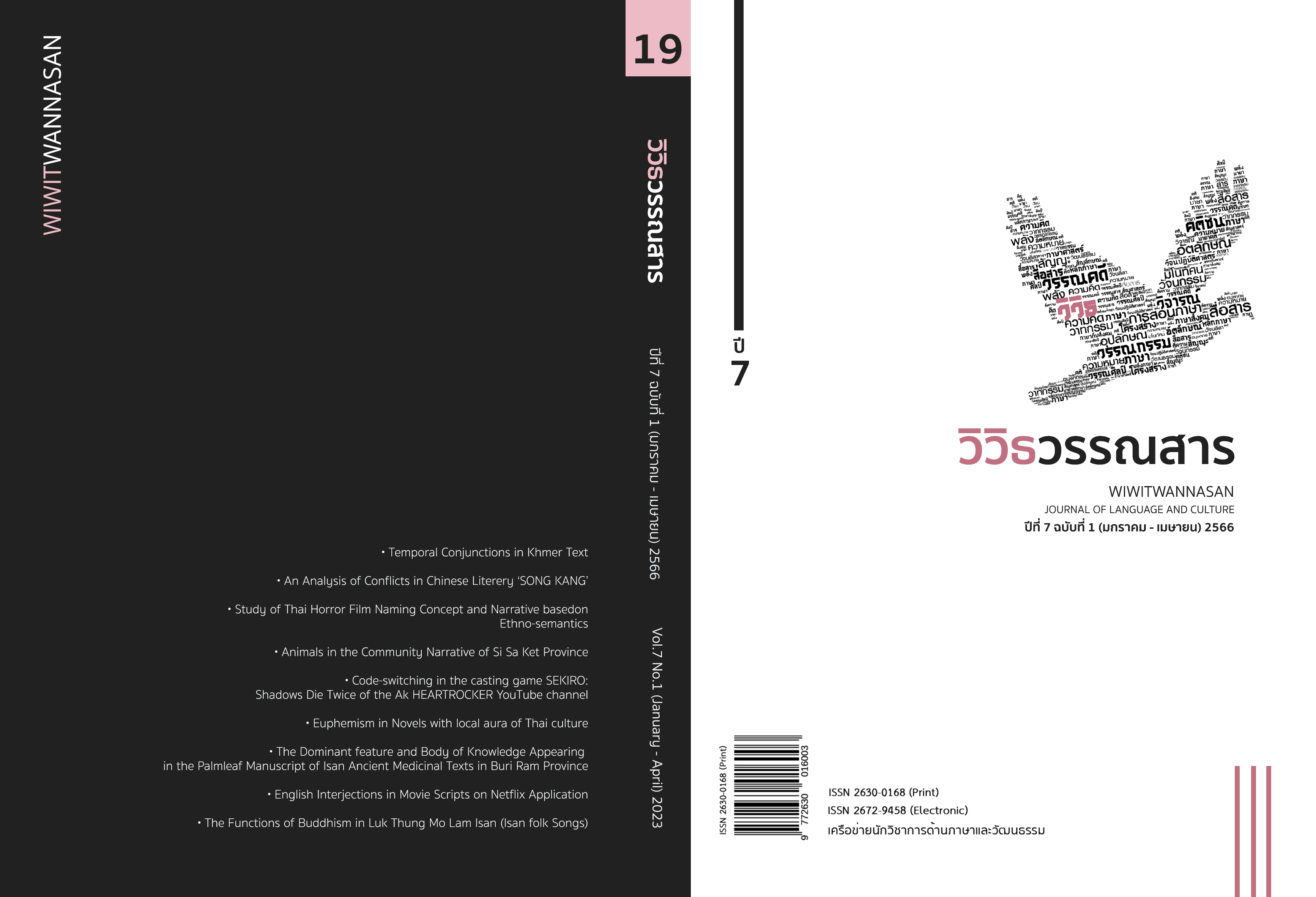คำอุทานภาษาอังกฤษในบทภาพยนตร์จากแอปพลิเคชันเน็ตฟลิกซ์
Main Article Content
บทคัดย่อ
การวิจัยในครั้งนี้มีวัตถุประสงค์ (1) เพื่อจำแนกคำอุทานภาษาอังกฤษในบทภาพยนตร์ที่ฉายใน
แอพลิเคชั่นเน็ตฟลิกซ์ (Netflix) และ (2) เพื่อวิเคราะห์การใช้คำอุทานในบริบทต่างๆ ที่พบในภาพยนตร์
โดยเก็บข้อมูลจากภาพยนตร์ 5 ประเภท 5 เรื่อง ที่เผยแพร่ในปี พ.ศ.2560 - 2563 และจัดอยู่ในตาราง 100 อันดับภาพยนตร์ยอดนิยมในแอพลิเคชั่นเน็ตฟลิกซ์ (Netflix) ของประเทศไทย ประจำปี พ.ศ.2563ได้แก่ ภาพยนตร์ตลก (Comedies) เรื่อง ฮอลิเดท (Holidate)ภาพยนตร์ระทึกขวัญ (Thriller) เรื่อง ลวง คร่า ฆาต (Dangerous lies)ภาพยนตร์ดราม่า (Drama) เรื่อง ศรัทธาคนบาป (The devil all the time) ภาพยนตร์รัก (Romance) เรื่อง คริสต์มาสแคลิฟอร์เนีย (A California Christmas)และภาพยนตร์บู๊ (Action) เรื่อง ดิ โอลด์ การ์ด (The Old Guard) วิธีการเก็บข้อมูลใช้วิธีการเชิงคุณภาพ โดยใช้เทคนิคการรวบรวมข้อมูล จากการดูภาพยนตร์ในแอพลิเคชั่นเน็ตฟลิกซ์ (Netflix) บันทึกคำอุทาน และแบ่งประเภทลงในตารางที่ออกแบบไว้ โดยประยุกต์ใช้แนวคิดของเดอร์กา ปราสาด (Durga Prasad) จากหนังสือ E-English Grammar (Interjection only) จากนั้นนำมาวิเคราะห์และสรุปว่าภาพยนตร์แต่ละประเภทมีการใช้คำอุทานแตกต่างกันอย่างไร และคำอุทานที่พบใช้ในบริบทใดบ้าง โดยอ้างอิงจากแนวคิดของ Nordquist (2019) ผลการวิจัยพบว่า คำอุทานภาษาอังกฤษที่พบในบทภาพยนตร์ทั้ง 5 เรื่อง สามารถจำแนกได้ 10 ประเภท ได้แก่ 1) คำอุทานแสดงยินดีหรือมีความสุข 2) คำอุทานแสดงความเศร้าโศก 3) คำอุทานแสดงความตกใจ4) คำอุทานแสดงการทักทาย 5) คำอุทานแสดงการชื่นชมยินดี 6) คำอุทานแสดงการเรียกความสนใจ 7) คำอุทานแสดงความประหลาดใจหรือปลื้มใจ 8) คำอุทานแสดงความเกลียดชัง 9) คำอุทานแสดงการให้และ 10) คำอุทานอื่นที่ไม่สามารถจำแนกประเทศได้อย่างชัดเจน โดยคำอุทานที่พบในภาพยนตร์ทั้ง 5 เรื่องมีทั้งหมด 2,017 คำ และ คำอุทานพบมากที่สุดในภาพยนตร์ตลก (Comedies) เรื่อง ฮอลิเดท (Holidate) จำนวน 723 คำหรือร้อยละ 35.84 และคำอุทานพบน้อยที่สุดในภาพยนตร์บู๊ (Action) เรื่อง ดิ โอลด์ การ์ด (The Old Guard) จำนวน 132 คำหรือร้อยละ 11.65 นอกจากนี้ประเภทคำอุทานที่พบมากที่สุดคือ คำอุทานแสดงการเรียกความสนใจ จำนวน 209 คำ และประเภทคำอุทานที่พบน้อยที่สุดคือ คำอุทานแสดงการเกลียดชัง จำนวน 37 คำ นอกจากนี้ผลการวิจัยยังพบว่าคำอุทานบางคำสามารถนำไปใช้ในบริบทที่แตกต่างกันขึ้นอยู่กับอารมณ์ของผู้พูด และสถานการณ์ที่เกิดขึ้น นอกเหนือจากคำอุทานที่แบ่งตามประเภททั้ง 10 ประเภทแล้ว ยังพบว่ามีคำอุทานบางคำที่สามารถใช้ได้ในบริบทที่แตกต่างกัน ขึ้นอยู่กับอารมณ์ของผู้พูด และสถานการณ์ที่กำลังเกิดขึ้นจากผลการวิจัยวสะท้อนให้เห็นว่า คำอุทานมีความสำคัญในการสื่อความหมาย สื่ออารมณ์ในบริบทต่างๆ แม้ว่าจะไม่ใช่คำที่จำเป็นในการสร้างประโยค แต่ก็ช่วยเติมเต็มการสนทนาให้สมบูรณ์มากขึ้น เหมาะแก่การศึกษาเพื่อนำไปใช้ในการเสริมประโยคการสนทนา และศึกษาเพื่อให้เข้าใจอารมณ์ความรู้สึกตัวละครในภาพยนตร์ รวมทั้งคู่สนทนาให้มากขึ้น
คำสำคัญ : คำอุทาน, บทภาพยนตร์, แอพลิเคชั่นเน็ตฟลิกซ์, ประเภทของภาพยนตร์
Article Details

อนุญาตภายใต้เงื่อนไข Creative Commons Attribution-NonCommercial-NoDerivatives 4.0 International License.
ลิขสิทธิ์ของบทความเป็นของวารสาร การพิมพ์ซ้ำจะต้องได้ร้บการอนุญาตจากบรรณาธิการวารสาร
เอกสารอ้างอิง
Dewi, S. P. (2020). Paper writing learning English through watching movies. SepuluhNopember Institute of Technology Surabaya.
Nordquist, R. (2019). A List of Interjections in English. Retrieved from https://docs.google.com/ document/preview?hgd=1&id=1I3JWuurvsB-nrDs0Wx6azvnH1icyzYgyARbW9P20er8.
Prasad, D. (2016). E-English Grammar (Interjection only) (E-book on Google). Retrieved from
https://books.google.co.th/books/about/E_English_Grammar_Interjection_only.
Rao, C. S. (2018). The Use of English Language in Research. SITECH, Hyderabad, India.
Reber, Elisabeth. (2012). Affectivity in Interaction: Sound objects in English. English and American Studies in German, 2012(1), 19-22. Retrieved from https://doi.org/ 10.1515/east-2012-0014.
Susiana. (2017). Interjection in Tangled movie script. English Education Program of Teachers’ Training and Education University of Muhammadiyah Sumatera Utara, Madan.
Thanaporn Chayeenate and Ratchaneekorn Sae-wang. (2019). Tendency of Watching Movies in Thai Society. Proceedings of the 10th Hatyai National and International Conference, Songkhla, Thailand, 12-13 July 2019. pp. 1055-1066.


